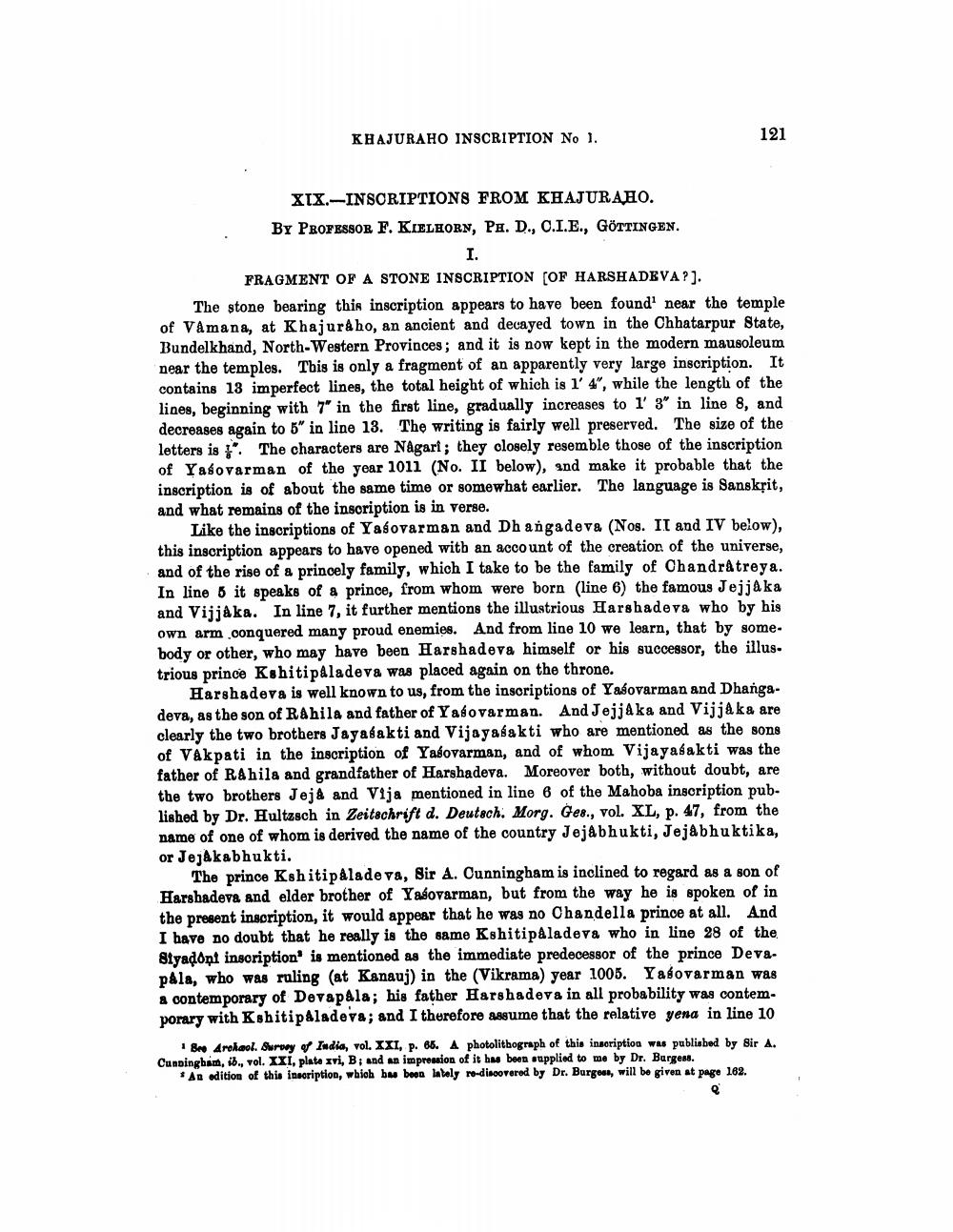________________
KHAJURAHO INSCRIPTION No ).
121
XIX.--INSCRIPTIONS FROM KHAJURAHO. BY PROFESSOR F. KIELHORN, PA. D., C.I.E., GÖTTINGEN.
I. FRAGMENT OF A STONE INSCRIPTION (OF HARSHADEVA?]. The stone bearing this inscription appears to have been found near the temple of Vamana, at Khajuraho, an ancient and decayed town in the Chhatarpur State, Bundelkhand, North-Western Provinces; and it is now kept in the modern mausoleum near the temples. This is only a fragment of an apparently very large inscription. It contains 18 imperfect lines, the total height of which is l' 4", while the length of the lines, beginning with 7 in the first line, gradually increases to l' 3" in line 8. and decreases again to 5" in line 13. The writing is fairly well preserved. The size of the letters is". The characters are Nagart; they closely resemble those of the inscription of Yasovarman of the year 1011 (No. II below), and make it probable that the inscription is of about the same time or somewhat earlier. The language is Sanskrit, and what remains of the inscription is in verse.
Like the inscriptions of Yasovarman and Dhangadeva (Nos. II and IV below), this inscription appears to have opened with an account of the creation of the universe, and of the rise of & princely family, which I take to be the family of Chandratreya. In line 5 it speaks of a prince, from whom were born (line 6) the famous Jejjaka and Vijjáka. In line 7, it further mentions the illustrious Harshadeva who by his own arm.conquered many proud enemies. And from line 10 we learn, that by some. body or other, who may have been Harshadeva himself or his successor, the illus. trious prince Kshitipaladeva was placed again on the throne.
Harshadeva is well known to us, from the inscriptions of Yasovarman and Dhangadeva, as the son of Rahila and father of Yalovarman. And Jejjaka and Vijjaka are clearly the two brothers Jayabakti and Vijayabakti who are mentioned as the sons of VAkpati in the inscription of Yasovarman, and of whom Vijayabakti was the father of Rahila and grandfather of Harshadeva. Moreover both, without doubt, are the two brothers Jeja and Vija mentioned in line 6 of the Mahoba inscription published by Dr. Hultzsch in Zeitschrift d. Deutsch, Morg. Ges., vol. XL, p. 47, from the name of one of whom is derived the name of the country Jejabhukti, Jejabhuktika, or Jejakabhukti.
The prince Kshitipalade va, Sir A. Cunningham is inclined to regard as a son of Harshadeva and elder brother of Yasovarman, but from the way he is spoken of in the present inscription, it would appear that he was no Chandella prince at all. And I have no doubt that he really is the same Kshitipaladeva who in line 28 of the Blyadont insoription' is mentioned as the immediate predecessor of the prince Deva. pala, who was ruling (at Kanauj) in the (Vikrama) year 2005. Yasovarman was a contemporary of Devapala; his father Harshadeva in all probability was contemporary with Kshitip&ladeve; and I therefore assume that the relative yena in line 10
866 Arolaol. Surowy of India, vol. XXI, p. 66. A photolithograph of this insoription was published by Sir A. Cunningham, ib., vol. XXI, plate xvi, B; and an impression of it has been supplied to me by Dr. Bargess.
* An edition of this inscription, which bus boon lately ro-discovered by Dr. Burgess, will be given at page 162.




